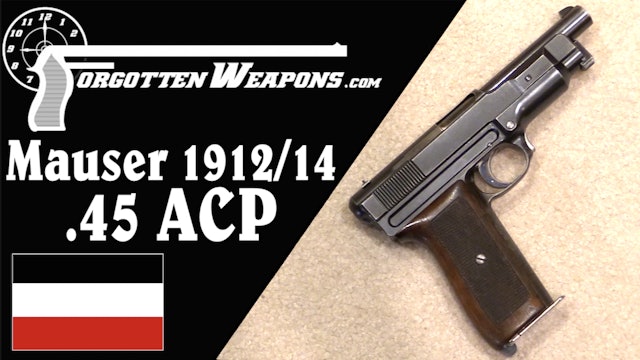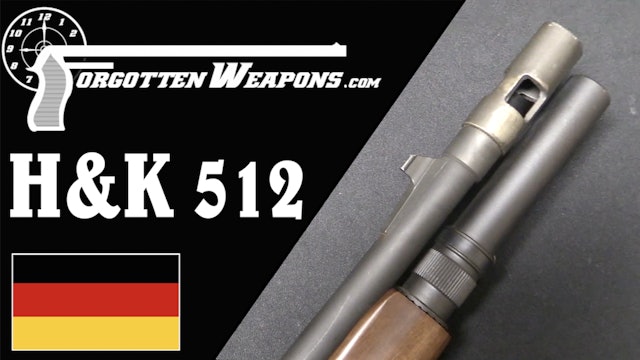-
Q&A 50: Disagreeing With the Premise of the Question
00:56 - What is the status of the Chinese Warlord Pistols book?
03:01 - Are open-bolt guns mechanically less accurate?
04:39 - Was Johnson influenced by the RSC?
06:02 - Arms development in totalitarian countries
09:03 - What is #36720?
10:27 - Design features to improve reliability in harsh... -
Japan's First Military Revolver: the S&W No.3
When Commodore Perry sailed into Tokyo Bay in 1853, he began a serious upheaval of Japanese life. Among other things, the insular Japanese society had been virtually the only nation to ever successfully implement gun control, with a virtually complete prohibition of any arms manufacture or import...
-
Captain Carl Pelo's Model 1954 Prototype Semiauto Rifle
Carl Pelo was a an engineer with Sako in the 1930s, and developed a series of self-loading rifles. He used a short recoil mechanism with a pair of locking flaps on the bolt, much like the Degtyarev machine guns from the Soviet Union. Pelo attempted to market his design both to the Finnish armed f...
-
The Mauser Train: High Adventure in the Last Days of WWII
Only days ahead of the French Army in April 1945, Ott-Helmuth von Lossnitzer and about 250 Mauser engineers and technicians fled Oberndorf with the core of Mauser's new projects. They had the drawings, components, and gages for guns like the new StG-45 assault rifle, MK214 aircraft cannon, and Vo...
-
Roth-Steyr 1907 at the Backup Gun Match
Posting a couple videos on interesting versions of the Roth-Steyr pistols recently made me think about just how nice of a pistol the 1907 is to shoot, So, I figured I'd bring it out to the monthly Backup Gun Match. Alas, I had ammo from two different lots, one of which would not reliably cycle th...
-
Earth-Shattering ka-Boom! How (and Why) Guns Explode
Just yesterday Scott at Kentucky Ballistics posted a very sobering video detailing his Serbu RN-50 quite literally exploding in his face. A lot of people have asked if I have seen it, and I figured this is a good opportunity to discuss the different ways in which guns can explode, and what some m...
-
Headstamp's Second Book! Thorneycroft to SA80: British Bullpup Firearms
I am very excited to be able to announce that Headstamp Publishing's second book, "Thorneycroft to SA80" is now in stock and shipping! As the name suggests, this is a study of British bullpup firearms, written by the Keeper of Arms & Artillery and the British National Firearms Centre, Jonathan Fe...
-
Adventures in Surplus: Mid-war "CE44" German Kar 98k
Today's rifle is a German Karabiner 98k, made by JP Sauer in 1944 and marked with the appropriate receiver code, "ce". This is from the final year of JP Sauer production of the K98k, before they transitioned to making the MP44 instead. It gives us a chance to look at how production standards chan...
-
Adventures in Surplus: Early Battle-Worn Berthier 1907-15
Today we are taking a look at a really interesting Mle 1907-15 Berthier rifle. This was the substitute pattern adopted by France as an infantry rifle to supplement the Lebel in 1915, and this particular one is one of the very first examples made. It has a carbine-style bent bolt handle, which was...
-
Roth Steyr Developmental Models 1904 and 1906
Before the Austro-Hungarian Empire adopted the Roth Steyr Model 1907 as its official cavalry pistol, they of course went through a series of pistol trials. The winners of two sets of trials were the Roth Steyr Models of 1904 and 1906, and today we have an example of each to look at.
-
Book Review: The Green Meanie - L96A1 by Steve Houghton
Following up on his 2018 "The British Sniper: A Century of Evolution", Steve Houghton has now released a followup book on the L96A1 in particular: "The Green Meanie". This rifles was a paradigm shift for sniping rifles, and a tremendous success for the British military. It is also a quintessentia...
-
1893 Lee-Metford Trials Carbine (One of Only 100 Made)
Once Lee-Metford rifle production was in place, the British began working on a carbine version of the same action for their cavalry. In 1893 a trial run of 100 carbines were made, and today we are looking at serial number 32 of that batch. These carbines differ in several ways from the ultimately...
-
Prototype Johnson Model R Military Rifle
When Melvin Johnson's rifle design was first going through US military testing in 1938, it was set up to use box magazines. These magazines were a problem - they were not quite fully perfected, and were causing a lot of the problem that the rifle was having. Johnson opted to withdraw the rifle fr...
-
Mauser 1912/14 in .45ACP
Before World War One, the Mauser company tried to make a follow-up automatic pistol to replace its famous C96 "Broomhandle" design with something more modern. The result was a very successful pocket pistol in .25ACP and .32ACP, and a series of unsuccessful blowback and delayed blowback service pi...
-
Tipo Alleggerito Beretta: Because Italian Gun Laws are Wacky
Today we are looking at two examples of prewar/wartime Beretta compact pistols. The first is a Tipo Alleggerito Model 34 in .380. This was developed because of a quirk in Italian law which prohibited the civilian sale of military small arms. Beretta had been selling the Model 1934 commercially fo...
-
DS-39: The Failed Soviet Machine Gun of World War Two
The Soviet Union recognized the need for a modernized machine gun to replace the Maxim, and in the late 1920s Degtyarev began work on a “universal” type of gun. This would be air cooled, use standard Maxim belts and 7.62x54R ammunition, and used as a tripod mounted infantry gun, a vehicle mounte...
-
Chinese Warlord Pistols: The Huge Shanxi .45 ACP Broomhandle
The best known and most highly valued of the Warlord Era Chinese pistols is undoubtedly the .45 ACP copy of the C96 Mauser. These were made at the Taiyuan Arsenal in Shanxi Province between 1928 and 1931, with more than 8,000 made in total. They were the product of a proper Western-style producti...
-
Shanghai 1900 Pistol-Carbine at the Backup Gun Match
Today I am going to actually do some shooting with a Chinese Warlord Era pistol - a Shanghai Model 1900 Pistol-Carbine. As I described in yesterday's video, these were well-made guns produced by a large and legitimate factory arsenal. I only have a single magazine (and sadly no shoulder stock) fo...
-
Chinese Warlord Pistols: Shanghai Model 1900 Pistol-Carbine
Not all of the handguns made in China during the Warlord Era were made one at a time by individual artisan gunsmiths. A few models were produced on proper Western-style production lines. Almost all of these production pistols were direct copies of the FN 1900 and Mauser C96, except for this fasci...
-
"Made for the Republic of China": Shanghai Arsenal's FN 1900 Copy
The Shanghai Arsenal was founded in 1865 as a joint venture between British and Chinese customs officers. They bought a defunct American ironworking company and rebuilt it as an arsenal. In 1884 they began production of a copy of the Remington Rolling Block, and by 1891 copies of Mannlicher 1888 ...
-
H&K 512 Old-School Tactical Shotgun
In the late 1970s, H&K decided that it wanted to offer a tactical shotgun for the police and security market. Having no experience with shotgun manufacture, they turned to Franchi in Italy - for whom they already handled sales outside Italy. Franchi produced a gas-operated semiautomatic shotgun ...
-
Colt's Prototype Scaled-Down Model 1910 in .38/9.8mm
With the impending success of Colt’s program to develop new .45 caliber pistol for the US military (the 1911), the company began to look for ways to exploit the work that had gone into it. They had previously sold lots of .38 caliber automatic pistols, so why not offer a .38 caliber version of t...
-
1896 Bittner: The Most Beautiful Steampunk Pistol
One of the very last, most common, and best looking of the Austrian manually operated pistols is the Bittner. Designed by Gustav Bittner in 1893 and going into production in 1896 (the known examples were proofed in 1897 and 1898), I think the Bittner is just about the most beautiful pistol I have...
-
Maxim-Silverman .455 Caliber Behemoth of a Pistol
Hiram Maxim’s hired shop supervisor was a man named Louis Silverman. He was a skilled engineer, who was treated rather poorly by Maxim, and whose contributions were systematically understated. One of the most interesting projects Silverman partook in was the design of a self-loading pistol in 18...

























